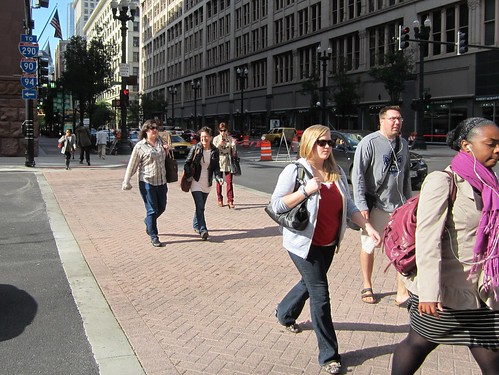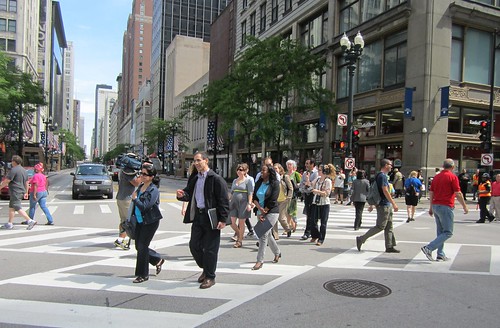The Mayor’s Pedestrian Advisory Council met last Wednesday, the day after an SUV driver struck and killed an 83-year-old man in Rogers Park, then fled the scene. At the meeting, Chicago Department of Transportation Commissioner Gabe Klein, co-chair of MPAC, along with Peter Skosey, vice president of the Metropolitan Planning Council, described the crash as “gruesome.” However, citywide the situation may be improving: There have been 16 pedestrian fatalities in Chicago through July of this year, down from 20 during the same time last year, Klein said.
Overall last year, there were 47 Chicago pedestrian fatalities, according to information released by the Illinois Department of Transportation on August 21. As Randy Neufield of the SRAM Cycling Fund and the National Complete Streets Coalition later commented, locations where multiple crashes happened should be given special consideration. "A lot of people don’t realize how real that is," he said.
One of the most important new street safety tools available to the city are speed enforcement cameras, the first of which started issuing warnings today. (By the end of the year, 50 will be installed.) CDOT’s David Pulsipher explained how the city decided where to site the cameras, which must be placed in "safety zones" near a school or park. After dividing the city into six regions, he said, CDOT mapped crashes and developed a point system to identify areas where speed enforcement should be a high priority, allotting double points for crashes involving victims under 18 and for speed-related crashes. They also identified “crash clusters” and measured vehicle speeds along high-crash corridors. To distribute the safety zones evenly, the agency won't place more than 20 percent or less than ten percent of the cameras in any one region.
CDOT staff also gave updates on a number of street redesigns and engineering . Klein spoke about the pedestrian scramble at State Street and Jackson Boulevard by DePaul University’s Loop campus, where pedestrian crossing is permitted in all directions during the "scramble" phase. To reduce conflicts as much as possible, Klein said, turns by motor vehicles are prohibited, Klein said, adding that the project is a testing ground for this configuration, which may be duplicated in other parts of the city. CDOT will collect data through September, when DePaul will be in session.
People seem to be confused about when the pedestrian phase begins (currently, the two full cycles of regular traffic signals happen before the "scramble" starts). Marcia Trawinski from Metro Seniors in Action called for a change to the audible announcements at the intersection so that it announces all crossing possibilities, an improvement that would increase access for visually impaired individuals. CDOT Pedestrian Program Manager Suzanne Carlson reacted positively to this suggestion and encouraged attendees to email any further suggestions or feedback about the intersection.
Construction has started on the long-awaited Berteau neighborhood greenway in the 46th Ward. The facility, known in other cities as a bike boulevard, contains a “whole toolbox [of features] to slow speeds down,” Carlson noted. “The speed limit is 20, but [the greenway] is designed for 20, which is even more important.”
CDOT took a similar approach by improving conditions for pedestrians and bicyclists on a 1.5-mile stretch of Madison Street between Pulaski Road and Central Avenue, a corridor with a high crash rate, as well as a high incidence of crime. After resurfacing the street, the agency installed buffered bike lanes, which calm traffic and make the street easier for pedestrians to walk across. “It’s actually great for pedestrians as well [as bicyclists] because the next thing near a pedestrian is a bicycle rather than a driving car,” Carlson said.
The next MPAC meeting will be held on Wednesday, November 6. Like the Mayor’s Bicycle Advisory Council meetings, these are open to the public.






